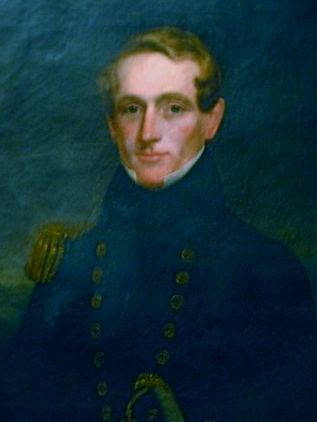SINCLAIR-ARTHUR
ARTHUR SINCLAIR III

CDR

Arthur Sinclair III was an officer in the U.S. Navy and later the Confederate States Navy. He was born on November 29, 1810, in Norfolk, Virginia, and joined the Navy at the age of 13 on March 4, 1824. After training as a Midshipman he became an officer and was commissioned as a Lieutenant on March 3, 1835. He was subsequently promoted to Commander on September 14, 1855. During his service he was a member of the 1853 expedition to Japan which tried to open up that country’s ports to American commerce and he commanded a ship which was reportedly named USS SUPPLY which carried gifts for the Japanese, the produce of U.S. industry.
Historical records indicate that the day Virginia seceded from the Union in 1861, CDR Sinclair stayed up all night with his old friend, and fellow Virginian and shipmate Captain David Farragut and they argued all night long in Sinclair’s study. The following morning Captain Farragut went North and CDR Sinclair resigned his commission in the U.S. Navy and on June 10, 1861, he joined the Confederate Navy with the rank of Commander. Given command of the CSS WINSLOW, he participated in the Battle of Hatteras Inlet in August 1861. Immediately following he took command of the ironclad warship CSS MISSISSIPPI while it was still being built but before it entered service the ship was torched before falling into enemy hands. CDR Sinclair was then sent to England and given command of CSS ATLANTA, a ship being converted for Confederate use, which he commanded through May 1863.
In 1864, CDR Sinclair was in Paris when he was ordered to return home. He proceeded to Liverpool, England, where he found a steamship which he thought would be an ideal ship as a blockade runner. Taking command he renamed it CSS LELIA after his wife and on January 14, 1965, set sail for North Carolina hoping to run the Union blockade. However, LELIA encountered bad weather off the coast of North Wales, was swamped by waves and sank. Three lifeboats were reportedly launched but only one reached safety and a survivor recalled his last sight of CDR Sinclair was kneeling on the deck in prayer. On the afternoon of May 31, 1865, a fishing vessel found the body of a man in the sea ten miles off the coast of Wales and the body was identified as Arthur Sinclair by his spectacles and gold watch. After an inquest was held, CDR Arthur Sinclair was buried in the Fleetwood Cemetery in Wyre Borough, Lancashire, England.
Submitted by CDR Roy A. Mosteller, USNR (Ret)

